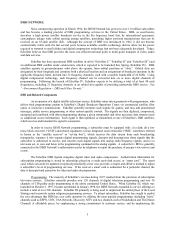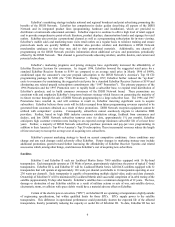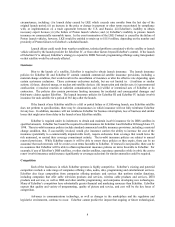Dish Network 1997 Annual Report Download - page 14
Download and view the complete annual report
Please find page 14 of the 1997 Dish Network annual report below. You can navigate through the pages in the report by either clicking on the pages listed below, or by using the keyword search tool below to find specific information within the annual report.12
competition to EchoStar’s full-CONUS service. In October 1997, the U.S. and Mexico signed a protocol allowing
cross-border fixed satellite service (“ FSS” ) service from Mexican-licensed satellites to the U.S. and vice versa.
The U.S. also has indicated its willingness to enter into similar agreements with other countries in North,
Central and South America. If the U.S. government moves forward with these initiatives, or if other countries
authorize DBS providers to use their orbital slots to serve the U.S., additional competition could be created, and
EchoStar’s DBS authorizations could become less valuable. At this time, EchoStar cannot predict whether these or
other recent developments will ultimately result in any additional service to the U.S.
Additional competition could be realized from operators using extended Ku-band spectrum and mid- and
high-power FSS spectrum to serve the U.S. DTH market. A significant amount of available full-CONUS spectrum
exists in these bands. Further, it may be possible to utilize Ka-band spectrum for DTH satellite applications,
particularly for spot-beam applications. Finally, other potential competitors may provide television programming at
any time by leasing transponders from an existing satellite operator.
Wireless Cable. Multichannel, multipoint distribution (“ wireless cable”) systems typically offer 20 to 40
channels of analog programming, which may include local programming (a potential advantage over most digital
satellite systems). Developments in high compression digital statistical multiplexing technology are expected to
increase significantly the number of channels and video and audio quality of wireless cable systems. Wireless cable
operators currently provide an analog signal, with limited capacity and inferior image and sound quality compared to
DBS. In order to upgrade their systems to implement digital transmission of high-quality video and audio signals,
wireless cable operators will be required to install digital decoders in each customer’s home at a cost comparable to the
cost of an EchoStar Receiver System and make certain modifications to their transmission facilities. The cost of such
digital upgrades will be significant and will have to be amortized over a smaller base of potential customers. Wireless
cable also requires direct line of sight from the receiver to the transmission tower, which creates the potential for
substantial interference from terrain, buildings and foliage. Wireless cable systems served over 1.0 million subscribers
at the end of 1997.
Telephone Companies. Certain telecommunications carriers, including regional bell operating companies and
long distance telephone companies, could become significant competitors in the future, as they have expressed an
interest in becoming providers of subscription television and information services. The Telecommunications Act of
1996 (the “ 1996 Act”) permits telephone companies to provide a variety of competitive video services, including
owning cable systems, with certain regulatory safeguards. It also is possible for telephone companies to provide high-
power DBS service, although any telephone company desiring to become a high-power DBS broadcaster must obtain
an FCC license for an available orbital location. The 1996 Act removes barriers to entry which previously inhibited
telephone companies from competing in the provision of video programming and information services. Several large
telephone companies have announced plans to acquire or merge with existing cable and wireless cable systems. As
more telephone companies begin to provide subscription television programming and other information and
communications services to their customers, additional significant competition for subscribers will develop. Among
other things, telephone companies have an existing relationship with virtually every household in their service area,
substantial economic resources, and an existing infrastructure and therefore may be able to subsidize the delivery of
programming through their position as the sole source of telephone service to the home.
VHF/UHF Broadcasters. Most areas of the U.S. are covered by traditional terrestrial VHF/UHF television
broadcasts that typically include three to ten channels. These broadcasters are often low to medium power operators
with a limited coverage area and provide local, network and syndicated programming. The local content nature of the
programming may be important to the consumer, and VHF/UHF programming is typically free of charge. The FCC
has allocated additional digital spectrum to licensed broadcasters. During a transition period ending in 2006, each
existing television station will be able to transmit programming on a digital channel that may permit multiple
programming services per channel. Broadcasters in certain of the largest cities in the continental U.S. will be required
to transmit digital signals during 1999. When broadcast affiliates begin transmission of local digital signals, consumer
demand for EchoStar’s Network Affiliates programming may be adversely affected.
Private Cable. Private cable is a multi-channel subscription television service where the programming is
received by a satellite receiver and then transmitted via coaxial cable throughout private property, often MDUs, without
crossing public rights of way. Private cable generally operates under an agreement with a private landowner to service
























